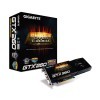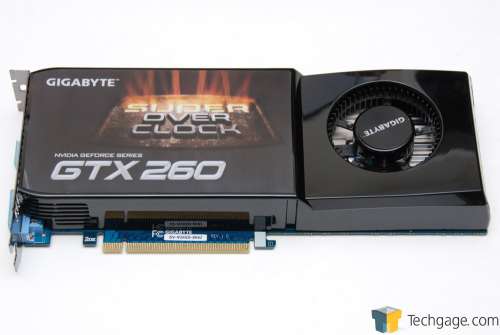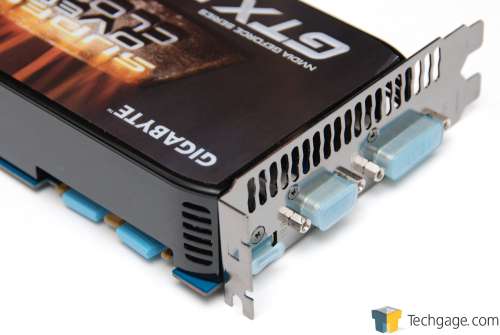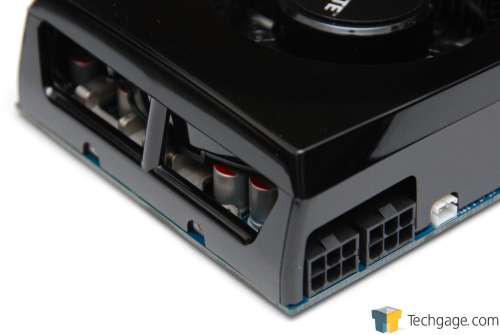- Qualcomm Launches Snapdragon 4 Gen 2 Mobile Platform
- AMD Launches Ryzen PRO 7000 Series Mobile & Desktop Platform
- Intel Launches Sleek Single-Slot Arc Pro A60 Workstation Graphics Card
- NVIDIA Announces Latest Ada Lovelace Additions: GeForce RTX 4060 Ti & RTX 4060
- Maxon Redshift With AMD Radeon GPU Rendering Support Now Available
Gigabyte GeForce GTX 260 Super Overclock

NVIDIA’s GeForce GTX 260 is not a new card. In fact, it’s been available for over a year in its 216 Core form. So is it even worth a look at today? Where Gigabyte’s “Super Overclock” version is concerned, yes. Although it costs less than a stock GTX 275, this new card beat it out in almost every single game and setting we put it through.
Page 1 – Introduction
Earlier this year, I posted a review of Sapphire’s Radeon HD 4870 Vapor-X graphics card, and at the time, I felt weird for doing it. The reason was simple. At that point in time, the HD 4870 wasn’t a new card. In fact, the HD 4890 was released just a month prior. So what was the point? At the time, ATI’s pricing structure was varied and Sapphire’s card featured 2GB of GDDR5, so, despite being based on a ten-month-old design, it was still relevant.
I had a bit of deja vu when Gigabyte contacted me a few weeks ago to take their latest GeForce GTX 260 for a spin. I immediately thought, “What the…”, because let’s face it, the GTX 260 is not a new card. The first iteration of the card came to market last June, while the revision, featuring 216 Shader cores, came in early October. So as it stands, the card we’re looking at today is essentially based on a model which was launched almost exactly a year ago.
So how is a review of this year-old card justified today? Like the aforementioned Sapphire review, the biggest part of the card’s relevancy again comes down to pricing. This particular model sells for $199, which puts it between all other GTX 260 cards and the GTX 275. Gigabyte justifies the price hike by offering the highest-clocked GTX 260 on the market, with 680MHz Core, 1500MHz Shader and 2500MHz memory clock speeds. With clocks such as these, the card looks to overtake, or at least match, the performance of the more-expensive GTX 275.
Closer Look at Gigabyte’s GeForce GTX 260 Super Overclock
Welcome to Gigabyte’s “Super Overclock” series. As the name suggests, cards belonging to this series will be shipped with higher clock speeds than what NVIDIA sets as reference. In the case of the reference GTX 260, the clocks are 576MHz Core, 1242MHz Shader and 1998MHz Memory. As you can tell by the specs mentioned above, Gigabyte has increased the clocks enough to have it become real competition to the next model up in NVIDIA’s line-up, the GTX 275, despite that card featuring more overall Shader cores (240 vs. 216).
In addition to featuring higher-than-reference clock speeds, Super Overclock cards go through extra care before earning their name. In what the company calls the “GPU Gauntlet” – essentially a cherry-picking process – Super Overclock cards are put through stringent testing to assure that they are the best available, not only from a performance perspective, but also to verify top-rate thermal efficiency and power switching capabilities.
As Gigabyte’s highest-end graphics series, these cards in turn include the company’s “Ultra Durable VGA” set of high-grade components. These include careful choosing of Samsung or Hynix memory chips, Japanese solid capacitors, Ferrite core metal chokes, low RDS(ON) MOSFETs, and not surprisingly, a PCB built using 2oz of copper for its inner layer. All of this might not mean much to most people, but it all comes down to a high-quality product – one that’s stable, runs cool and is very, very overclockable.
Currently, NVIDIA’s graphics card line-up is rather slim, with six real choices overall. The last generation 9800 GT is at or under $100, putting it in a different category from the others. The GTS 250 card starts off at around $125, and we move up to the GTX 285, which sells for just over $300. At this point in time, we wouldn’t recommend considering a GTX 295 for purchase, as AMD’s Radeon HD 5870 X2 is right around the corner and will likely have a similar cost. Even if that’s not the case, given the sheer improvement that current HD 5000 cards show over previous generations, it should theoretically be twice as fast as the GTX 295.
|
Model
|
Core MHz
|
Shader MHz
|
Mem MHz
|
Memory
|
Bus Width
|
Processors
|
| GeForce GTX 295 |
576
|
1242
|
1000
|
1792MB
|
448-bit
|
480
|
| GeForce GTX 285 |
648
|
1476
|
1242
|
1GB
|
512-bit
|
240
|
| GeForce GTX 275 |
633
|
1404
|
1134
|
896MB
|
448-bit
|
240
|
| GeForce GTX 260 |
576
|
1242
|
999
|
896MB
|
448-bit
|
216
|
| GeForce GTS 250 |
738
|
1836
|
1100
|
1GB
|
256-bit
|
128
|
| GeForce 9800 GT |
600
|
1500
|
900
|
512MB
|
256-bit
|
112
|
Enough about the other cards though, and more about the one in our test bench today. As you can see below, although Gigabyte has bumped each one of the clocks on the card far beyond reference speeds, it’s opted to stick with the reference cooler. Although this cooler design is more than capable of keeping cards cool and allow for good overclocking-ability, it would have been nice to see a custom design given this is a special series.
At the back, we have the option to use DVI, HDMI or VGA. If you want to use more than one monitor but neither uses an HDMI port, Gigabyte includes an HDMI-to-DVI adapter in the box that should remedy the problem.
Just like the rest of the current mid-range cards from both ATI and NVIDIA, the GTX 260 sticks to a 2x PCI-E 6-pin power setup. As the card carries a TDP of 182W, NVIDIA recommends a power supply with of at least 500W, although for a card pre-overclocked such as this, its recommendation would likely increase to 550W.
Throughout our testing results, one thing we want to pay attention to is how this card compares to the slightly more expensive (~$25) GTX 275. Our GTX 260 here has 24 less Shaders, but our ultra-high clocks may negate the loss of those. On the following page, we’ll go over our testing methodology and machine specs, and then we’ll get right into our results, kicking things off with Call of Duty: World at War.
Support our efforts! With ad revenue at an all-time low for written websites, we're relying more than ever on reader support to help us continue putting so much effort into this type of content. You can support us by becoming a Patron, or by using our Amazon shopping affiliate links listed through our articles. Thanks for your support!








